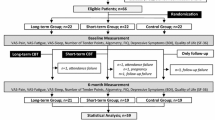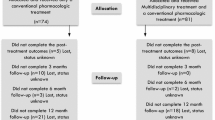Abstract
The purpose of this study was to evaluate the efficacy of a multidisciplinary treatment program in patients severely affected by fibromyalgia. Thirty-four fibromyalgia patients were randomly divided into two groups. The control group: 17 women who continued their medical treatment and participated in four educational sessions and the experimental group that included 17 patients who besides the former medical treatment also underwent a weekly 1-h session program for 8 weeks including massage therapy, ischemic pressure on the 18 tender points, aerobic exercise and thermal therapy. At the beginning of the program, there were no significant differences between the two groups in any of the parameters. At the end of treatment, there was a significant improvement in the experimental group in the following items: vitality, social functioning, grip strength and the 6-min walk test. At 1 month after the end of treatment, the experimental group showed significant differences in overall health perception, social functioning, grip strength and the 6-min walk test. At that time, considering the threshold for clinical efficacy set at an improvement of 30% or above for the analyzed variables, 25% of the patients met the requirement for improvement of the following: number of symptoms: Visual Analogic Scale for fatigue, Fibromyalgia Impact Questionnaire and Beck Anxiety Inventory. In conclusion, patients with severe manifestations of fibromyalgia can obtain improvement with a short-term, low-cost and simple-delivery multidisciplinary program. However, additional studies including higher numbers of patients are needed to confirm the beneficial effect of this treatment program.


Similar content being viewed by others
Abbreviations
- ACEF:
-
Association of Fibromyalgia Patients of Cantabria
- ACR:
-
American College of Rheumatology
- NSAIDs:
-
Non-steroidal anti-inflammatory drugs
- ANOVA:
-
Variance analysis
- BAI:
-
Beck Anxiety Inventory
- BDI:
-
Beck Depression Inventory
- VAS:
-
Visual Analog Scale
- FIQ:
-
Fibromyalgia Impact Questionnaire
- FM:
-
Fibromyalgia
- FSS:
-
Fatigue Severity Scale
- HAQ:
-
Stanford Health Assessment Questionnaire
- HAS:
-
Hamilton Anxiety Scale
- MPQ:
-
McGill Pain Questionnaire
- MT:
-
Multidisciplinary treatment
- NS:
-
No significant differences
- PSQI:
-
Pittsburgh Sleep Quality Index
- SER:
-
Spanish society of rheumatology
- SF-36:
-
Medical outcomes survey short form-36
- TP:
-
Tender Points
- ZDS:
-
Zung Depression Scale
References
Wolfe F, Smythe HA, Yunus MB et al (1990) The American College of Rheumatology 1990 criteria for the classification of FM: report of the multicenter criteria committee. Arthritis Rheum 33(2):160–172
Casanueva FB (ed) (2007) Tratamiento no-farmacológico, farmacológico, estrategias multidisciplinarias, medicina alternativa y complementaria. In: Tratado de Fibromialgia, 1st edn. Editorial Cantabria, ISBN: 978-84-611-6618-3, pp 659–862
Melzack R (1975) The McGill Pain Questionnaire: major properties and scoring methods. Pain 1:277–299
Krupp LB, LaRocca NG, Muir-Nash J et al (1989) The Fatigue Severity Scale. Application to patients with multiple sclerosis and systemic lupus erythematosus. Arch Neurol 46:1121–1124
Hamilton M (1959) The assessment of anxiety states by rating. Brit J Med Psychol 32:50–55
Beck AT, Brown G, Epstein N et al (1988) An inventory for measuring clinical anxiety: psychometric Properties. J Consul Clin Psychol 56:893–897
Zung WWK (1965) A self-rating depression scale. Arch Gen Psychiatry 12:63
Beck AT, Ward CH, Mendelson M et al (1961) An inventory for measuring depression. Arch Gen Psychiatry 4:561–571
Buysse DJ, Reynolds CF 3rd, Monk TH et al (1989) The Pittsburgh Sleep Quality Index: a new instrument for psychiatric practice and research. Psychiatry Res 28(2):193–213
Burckhardt CS, Clark SR, Bennett RM (1991) The Fibromyalgia Impact Questionnaire: development and validation. J Rheumatol 18:728–733
Bruce B, Fries JF (2003) The Stanford Health Assessment Questionnaire: dimensions and practical applications. Health Qual Life Outcomes 1(1):20
McHorney CA, Ware JE, Lu R et al (1994) The MOS 36-items short form health survey (SF-36) III. Tests of data quality scaling assumptions, and reliability across diverse patient groups. Med Care 32:40–66
Masi AT (1994) An intuitive person-centred perspective on fibromyalgia syndrome and its management. Baillieres Clin Rheumatol 8(4):957–993
Turk DC, Okifuji A, Sinclair JD et al (1998) Interdisciplinary treatment for fibromyalgia syndrome: clinical and statistical significance. Arthritis Care Res 11(3):186–195
Zijlstra TR, Van de Laar MA, Bernelot Moens HJ et al (2005) Spa treatment for primary fibromyalgia syndrome: a combination of thalassotherapy, exercise and patient education improves symptoms and quality of life. Rheumatology (Oxford) 44(4):539–546
Burckhardt CS (1994) Arthritis and musculoskeletal patient education standards. Arthritis Care Res 7:1–4
Solomon DH, Warsi A, Brown-Stevenson T et al (2002) Does self-management education benefit all populations with arthritis? A randomized controlled trial in a primary care physician network. J Rheumatol 29(2):362–368
Nicassio PM, Radojevic V, Weisman MH et al (1997) A comparison of behavioral and educational interventions for fibromyalgia. J Rheumatol 24(10):2000–2007
Gowans SE, De Hueck A, Voss S et al (1999) A randomized, controlled trial of exercise and education for individuals with fibromyalgia. Arthritis Care Res 12(2):120–128
Henriksson C, Carlberg U, Kjallman M et al (2004) Evaluation of four outpatient educational programmes for patients with longstanding fibromyalgia. J Rehabil Med 36(5):211–219
Buckelew SP, Conway R, Parker J et al (1998) Biofeedback/relaxation training and exercise interventions for fibromyalgia: a prospective trial. Arthritis Care Res 11(3):196–209
Fontaine KR, Conn L, Clauw DJ (2010) Effects of lifestyle physical activity on perceived symptoms and physical function in adults with fibromyalgia: results of a randomized trial. Arthritis Res Ther 12(2):R55
Da Costa D, Abrahamowicz M, Lowensteyn I et al (2005) A randomized clinical trial o fan individual home-based exercise programme for women with fibromyalgia. Rheumatology (Oxford) 44(11):1422–1427
Gansky SA, Plesh O (2007) Widespread pain and fibromyalgia in a biracial cohort of young women. J Rheumatol 34(4):810–817
Acknowledgments
Our appreciation to: ACEF (Association of Fibromyalgia from Cantabria) for their participation in the study. To Ms. María Nieves Ortega Fernández, Graduate in Philosophy and Arts, and to Mr. Alberto Luceño Vázquez, Professor of Applied Mathematics at the University of Cantabria, for his collaboration in the collection and statistical analysis of data.
Conflict of interest
The authors declare that they have no conflict of interest.
Author information
Authors and Affiliations
Corresponding author
Rights and permissions
About this article
Cite this article
Casanueva-Fernández, B., Llorca, J., Rubió, J.B.i. et al. Efficacy of a multidisciplinary treatment program in patients with severe fibromyalgia. Rheumatol Int 32, 2497–2502 (2012). https://doi.org/10.1007/s00296-011-2045-1
Received:
Accepted:
Published:
Issue Date:
DOI: https://doi.org/10.1007/s00296-011-2045-1




